Survey Report: Top Software Development Challenges for 2023
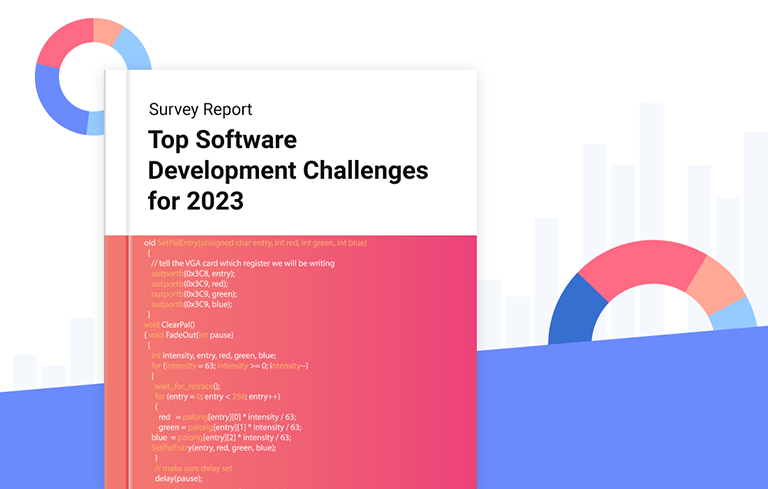
Developer shortage remains a key challenge for the second year in a row, the 2023 Annual Software Developer Survey finds.
Keeping pace with innovation in developer tools, managing workload, security threats, and project management are other major pain points for 2023. The survey also revealed that software developers continue to struggle with communication and collaboration tools in the new digital environment.
To find out what obstacles faced developers in 2022 and bring to light their future challenges, we surveyed over 2,000 software developers and IT professionals to determine their biggest pain points, challenges, and areas for growth.
The survey examined:
- How the industry is addressing the short supply of software developers
- The hardest-to-fill technical jobs
- How the industry is addressing communication/collaboration difficulties within remote and hybrid teams
- The burgeoning popularity of embedded analytics and business intelligence
- Momentum in 2022 and plans for growth in 2023
This survey report analyzes our key findings on how software developers plan to address these challenges, adopt new tools and technologies, and deploy resources in order to thrive in 2023.
Key Findings
The biggest business challenge in 2023 remains the same as last year – recruiting developers with the right skills. More than a third of respondents (37.5%) indicated that they will continue to have trouble finding skilled developers in 2023.
The tech talent shortage shows no signs of abating and the US Labor Department estimates that the global shortage of software engineers may reach 85.2 million by 2030. The talent shortage has many implications for the tech industry, including difficulty competing and innovating, higher costs, and lost revenue. Among the ways organizations are addressing the talent shortage are by lowering the demands on developers by adopting new technologies and applications, including low-code tools. The survey also identified the most in-demand jobs in the IT industry.
In addition to the developer shortage, the survey found that other top business challenges for 2023 are keeping employees safe, (37.2%) and limited resources (36.5%). Over the past three years, workers have been faced with a series of unexpected challenges -- the COVID-19 pandemic, an economic downturn, and a volatile work environment-- which is pushing employers to do more to assure workers are protected. Employers that take steps to protect their employees will be more likely to retain them, especially in light of the developer shortage.
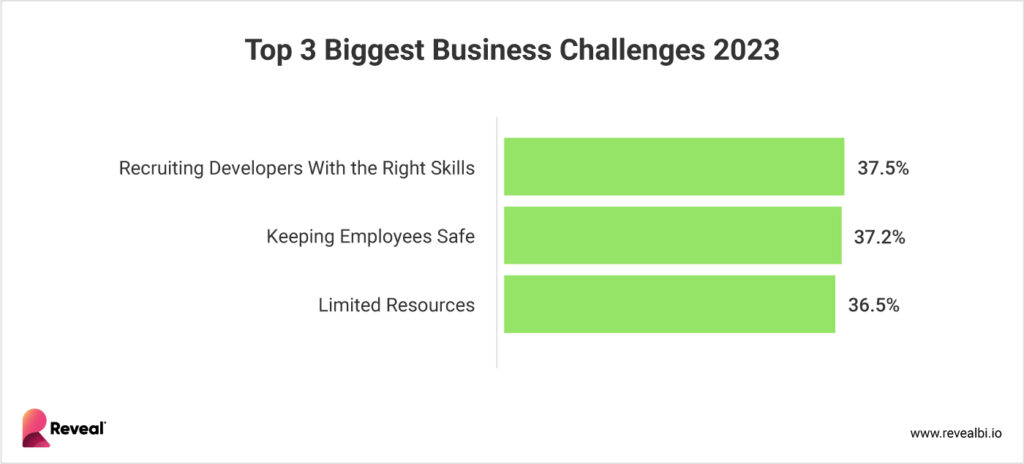
Top Software Development Challenges
The most recent U.S. labor market data reported the lowest unemployment rate since 1969, adding 517,000 jobs in January alone. Amid layoff announcements by U.S.-based tech companies in 2022, we examined which will be the most in-demand jobs in the technology industry.
The top three technical jobs that will be hardest to fill in 2023 are: DevOps Engineer (16.39%), Data Analytics Developer (16.27%), and IT Security Engineer (13.4%).
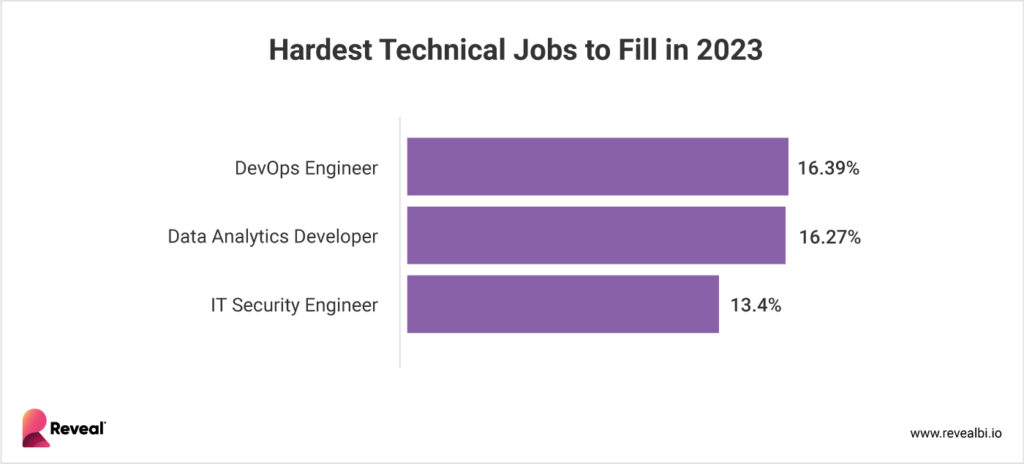
While nearly all developers (88.8%) work with a designer or design team, nearly half of a developer’s time (43.4%) is spent on coding an app. The lack of skilled developers challenge is being solved by the use of low-code/no-code tools in three-quarters (76.8%) of organizations. Low-code/no-code tools like App Builder help digital product teams create applications with visual tools that require little to no up-front coding – they merely need a development team to ‘finish’ an application before deployment. This approach is helping alleviate the demand for developers by reducing the need for heavy hand-coding in areas like screen design, UX flows, theming, and branding and can all but eliminate the need for manual HTML & CSS tweaking.
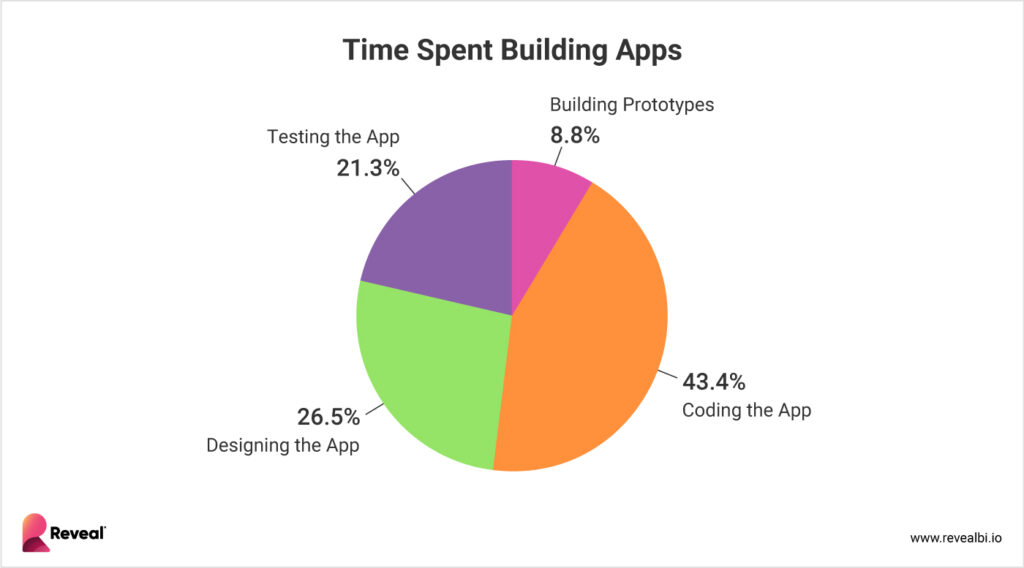
Software developers plan to better utilize their resources in 2023 by improving project management (30%), improving designer/developer collaboration (30%), using software that will work for citizen developers (27%), utilizing remote staff (25%), and incorporating a data catalog/analytics catalog (25%).
The biggest software development challenges in 2023 will be the inability to keep pace with innovation in developer tools (27.7%), difficulty with third-party integration (26.70%), struggle to manage workload (26.2%), security threats (26.10%), project management (26.10%) and client expectations too high (26%).
Many of these project management and collaboration challenges can be overcome with a digital workplace productivity tool. Slingshot, for example, helps align remote teams and foster better work communication. Featuring project and task management, content management, collaboration, data analytics, and data catalog capabilities, Slingshot allows teams to manage workloads more intelligently, stay on top of deadlines, and start making smarter business decisions that are backed up by hard facts.
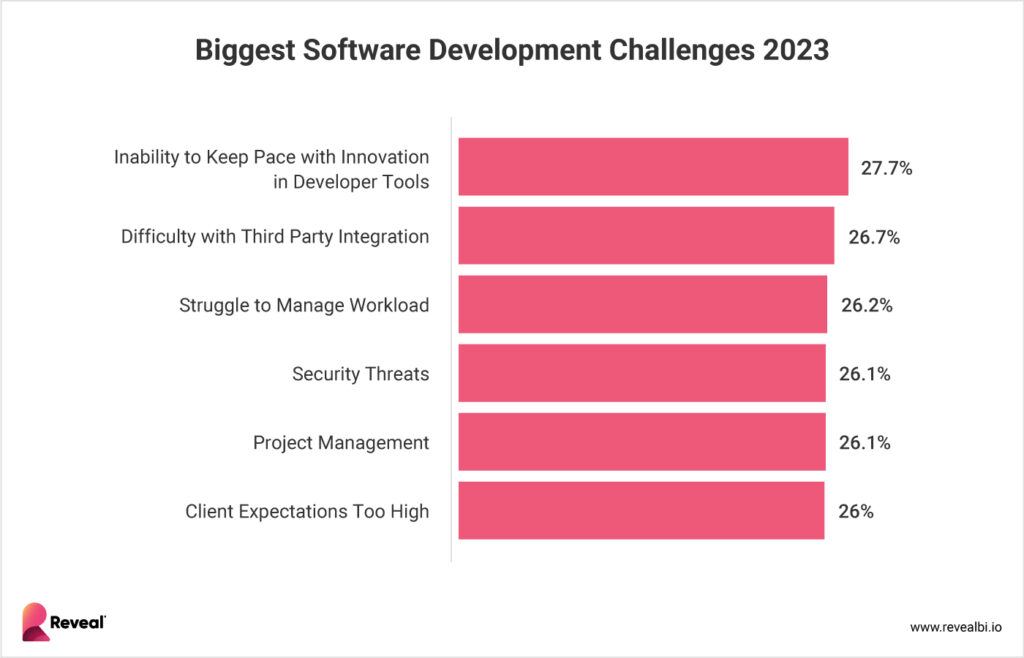
Deploying Resources Through Digital Transformation
Now that many organizations have moved to remote/hybrid teams and downsized their physical presence, the back-to-work challenges from 2022 have been mostly resolved, as indicated by the 23% reduction in efforts to move employees to remote work. However, difficulties communicating and collaborating with team members in the new digital environment remain as only 18.6% of organizations are fully on-site.
The remote/hybrid workplace has resulted in a myriad of issues as software developers installed new online collaboration tools and sought ways to improve productivity. While more than half of respondents (57.9%) reported having more time to complete work projects due to reduced commuting time, four in ten (42%) have trouble keeping track of projects and a third (31.9%) said they are less productive in the hybrid environment. This is where the usage of all-in-one digital workplaces, as mentioned above, becomes of great value to organizations looking to increase productivity and improve results.
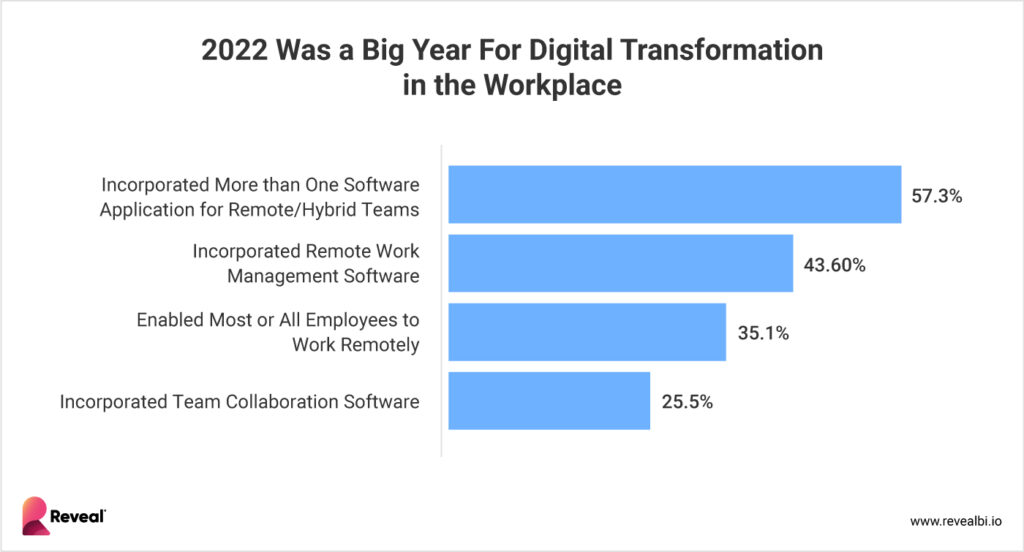
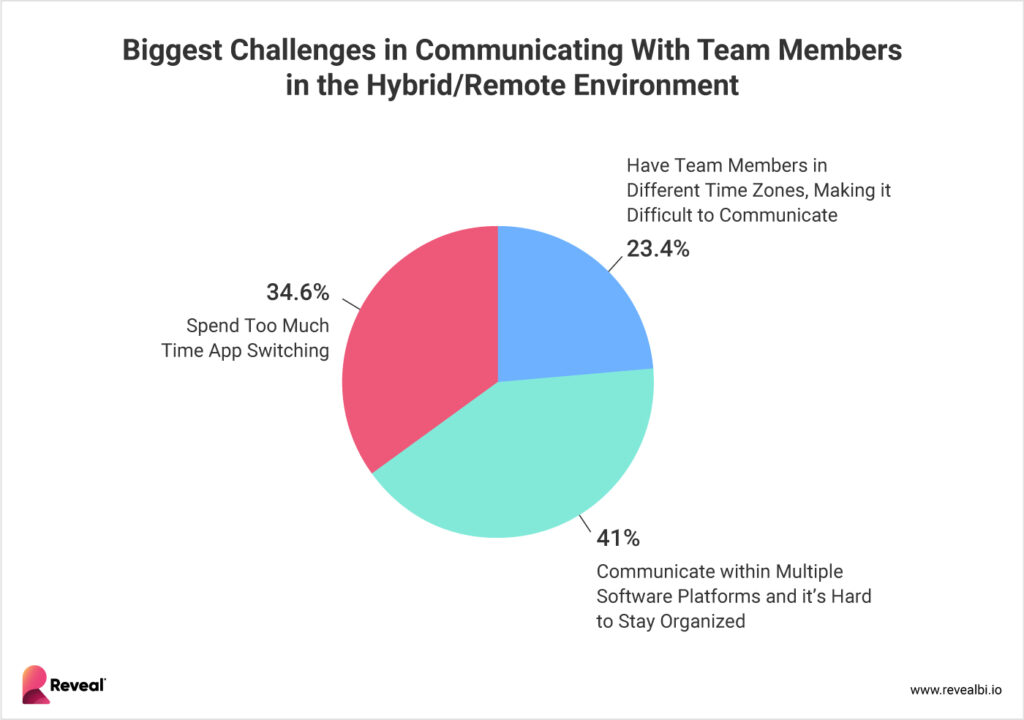
A third of software developers incorporated new software for remote/hybrid workers in 2022 as they struggled to identify the best ways to ensure optimal productivity. More than half (54.4%) want to use one tool where everyone can collaborate and resolve issues. Another 47.5% would like to automate workflows and processes and 43.7% prefer to eliminate manual file sharing.
Embedded Analytics is Still on the Rise
Embedded analytics and business intelligence continue to rise in popularity with eight in ten software developers (80.8%) incorporating these analytics tools into their products in 2022, a 3% gain over 2021.
The demand for embedded analytics in apps developed for clients is also burgeoning with 48% of developers embedding analytics into client apps in 2022, compared to 30.8% in 2021. And 74.9% of software developers expect their organization’s focus on business intelligence to increase in 2023.
While it has many benefits, the top three reasons software developers are using embedded analytics are:
- Improving customer satisfaction (32%)
- Gaining a competitive advantage (30.1%)
- Making data-driven decisions (24.7%)
In addition to helping end users uncover insights without the help of data analytics experts, embedded analytics has many other advantages, including:
- Quicker time to market
- Contextualized analytics
- Revenue growth
- Ease of use
- Data Confidentiality
The main reasons that customers are demanding embedded analytics in their software are to improve productivity (41.6%), increase sales/revenue (39.5%), understand business problems (33%), and make better business decisions (31.8%).
More and more organizations will be embracing embedded analytics tools in 2023 because they are the key to achieving a competitive edge and business growth. Here are a few important trends that will shape the future of business intelligence in 2023:
- Data-as-a-Service (DaaS) - DaaS is a data management strategy that uses the cloud to deliver data integration, processing, storage, and/or analytics services via a network connection in order to improve the agility of data workloads, accelerate time-to-insight, and increase the reliability and integrity of business data.
- Data Clean Rooms - Sharing data while adhering to privacy regulations has always been a challenge for businesses. But data clean rooms are here to change that for the better. By using data clean rooms, it’s now possible to manage data effectively, identify it, and share it in a secure manner that aligns with privacy rules.
- ESG - Environmental, Social, and Governance are three key data analytics components that in 2023 companies will need to embrace so they can determine the environmental efficacy and sustainability of their organization.
- AI - AI and machine learning algorithms revamp the way users interact with analytics and data management by helping to create or provide data fabric capabilities, intelligent organization data catalogs, AI-powered data cleansing, self-service data preparation, and more.
- Data Lakehouse – Many businesses have already made heavy investments in technology, cloud platforms, and digital systems. To get a higher ROI on these investments, these organizations need to combine data lakes and data warehouses to form a data lakehouse that brings extra speed, storage, and operational efficiencies.
How the Software Industry Fared in 2022
The data shows that there has been a slight downturn in momentum and a decrease in revenue growth for software developers with just 18.8% of software developers reporting an increase in revenue in 2022, compared to 25% in 2021. However, software developers reported a nearly 10% drop in the number of layoffs and a significant decrease in funding loss in 2023, which are industry bright spots.
The percentage of developers who took on new projects dropped slightly in 2022 with 33.3% reporting new endeavors, compared to 36.22% in 2021. Just a quarter (25%) expanded into new markets, a drop of 8% over the previous year. Requests for proposals also declined in 2022, with a 12% decrease over 2021.
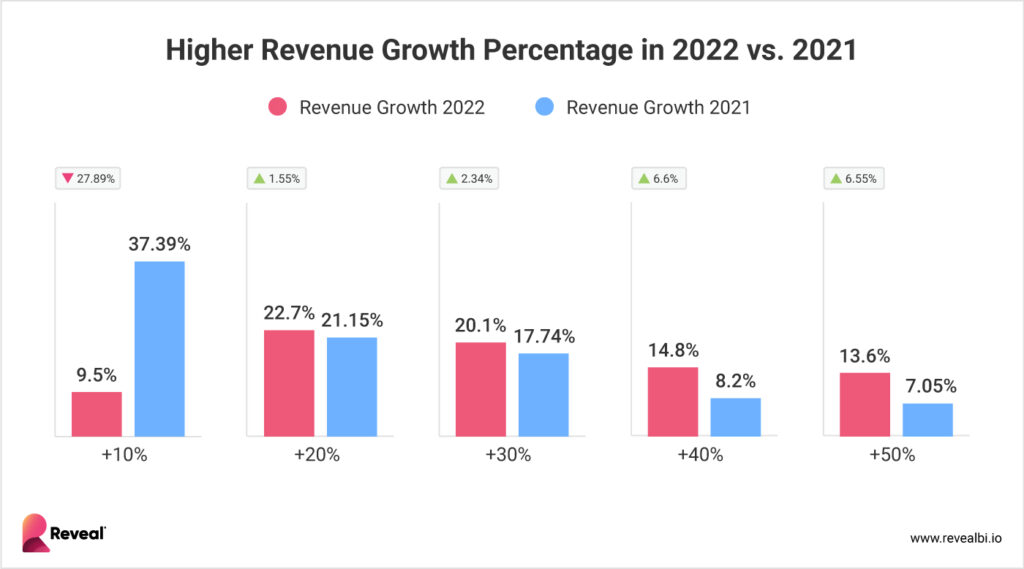
Tech companies expanded rapidly during the pandemic and although some are restructuring and belt-tightening in the wake of overexpansion, digital transformation initiatives provide new opportunities for growth and revenue for software developers. Amid this slowdown, businesses will continue to invest in IT infrastructure, and applications, improving customer experience, and digital transformation initiatives.
How Software Developers Will Grow the Business in 2023
While the 2022 growth results were somewhat disappointing, the software development industry has big plans for growth in 2023.
The software development industry’s expansion plans for 2023 are:
- Adopt new technologies/applications (37.90%)
- Expand into new markets (35%)
- Take on new projects (32.50%)
- Increase revenue (31.40%)
- Increase in requests for proposals (31.40%)
Adopting new technologies/applications can add great revenue opportunities for companies. At the bare minimum, such technologies and applications lower costs and save money. On the other hand, incorporating new features into your products enhances the value of your offering, so you can increase your pricing, or offer those as special features to up-sell to clients.
For example, let’s imagine that you have property management software and recently introduced BI capabilities as part of your suite of features to help your customers easily analyze data regarding their vacation rental units. For the purpose of our example, let’s say that you charge your customers $5 per user per month. You can include all your property management features in that pricing and then have the analytics solution sold at a fixed price, on top of the seat-based pricing.
Conclusion
The software development industry continues to face a struggle in filling skilled software development positions as we race to digitize the business world. However, low code/no code tools are helping to alleviate the talent shortage. The survey also found that while back-to-work challenges have been mostly resolved, the industry continues to face a real challenge in communication and collaboration within teams, especially those working hybrid and remotely. Fortunately, new digital workplace software platforms are helping to better connect teams, no matter where they are. While 2022 showed a slight downturn in momentum, 2023 is expected to be a year for new technology adoption, expansion into new markets, and increased revenue.
The tech industry by its very nature will continue to experience significant changes and developments as an onslaught of new technologies will open the door to new innovations, especially in the hybrid workplace. Tech companies that want to weather the storm must keep pace with new tools and technologies. Innovation means more disruption while at the same time more opportunity for those who can keep up and evolve.
About the survey
Over 2000 software developers and IT professionals participated in Infragistics’ Reveal 2023 survey from December 2022 to January 2023.
Continue Reading
Fill out the form to continue reading.
